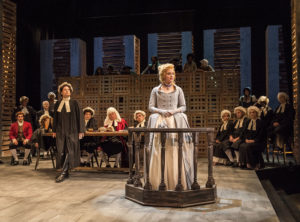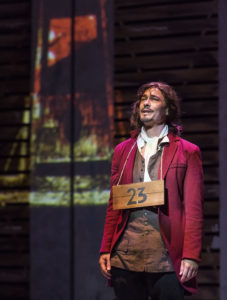
Lucie Manette (Emily Goss) testifies at the London trial of Charles Darnay (all photos by Craig Schwartz)
“It was the best of times, it was the worst of times.” With those words novelist Charles Dickens began his classic book A Tale of Two Cities, published in 1859. The two cities were London and Paris and the defining event of the book was the French Revolution’s Reign of Terror in which the newly empowered French citizens sent hundreds of aristocrats, including eventually their king and queen, to the guillotine. There have been over a dozen adaptations for film and television, a few stage adaptations and even a few musical stage adaptations. Dickens’ material deserves a musical akin to Les Miserables, especially since it takes place during the more important French Revolution. A Noise Within in Pasadena launched its 26th season with British playwright Mike Poulton’s adaptation. Any adaptation of a novel with the breadth of time spanned and the multitude of characters depicted as in this Dickens’ tale is bound to feel like a CliffsNotes rendition. Unfortunately Poulton has chosen to highlight a lot of the wrong notes in his re-telling.

Charles Darnay (Tavis Doucette) on trial before the French revolutionary “reign of terror”
He skips the first third of the book entirely, dropping a few pertinent facts here and there in later conversations. The audience never gets a sense of the hopelessness faced by Dr. Manette (Nicholas Hormann), a French physician unjustly imprisoned in the Bastille for 18 years, and his now grown daughter Lucie (Emily Goss) as they try to reconnect. The audience doesn’t get to witness French aristocrat Charles Darnay’s (Tavis Doucette) first meeting with the Manettes and their budding relationship. The play begins at Darnay’s London trial for treason where he is saved at the last minute from a guilty sentence by the Perry Mason style courtroom antics of his lawyer Sydney Carton (Frederick Stuart). The role of Carton has been reduced from leading player to supporting character in this adaptation. His love for Lucie really is never fleshed out on stage. Also Poulton has done away with the character of Little Lucie altogether, depriving Carton of another solid reason for his final act of bravery. Instead a pregnant Lucie travels to Paris to try to save her now imprisoned husband from the guillotine only to give Madame Defarge (Abby Craden) a chance to threaten to cut the unborn child out of her mother’s womb. The seldom seen knitting Madame Defarge is another character reduced to a few walk on scenes in this version.

Sydney Carton (Frederick Stuart) awaits his fate
Directors Julia Rodriguez-Elliott and Geoff Elliott keep the action flowing at a good pace and there is a lot of energy in the mob scenes but this script never really delivers its emotional impact. The cast is competent, many playing multiple roles, but this revolution never fully ignites. Lucie is the “Golden Thread” that binds the various characters together and Goss does a fine job of shouldering that burden. Fred Kinney’s framework and box scenic design easily transforms into the various locations and the action is well lit by Ken Booth. Jenny Foldenaur’s costumes are as elegant for the aristocrats as they are grubby for the peasants. But why does Madame Defarge never own a pair of shoes, pre or post revolution if her husband is a successful wine merchant and they are in a power position in the new Paris? If you intend to see this production of A Tale of Two Cities and are not familiar with the material, I would suggest reading the novel beforehand or at least skimming through the CliffNotes version.
A Noise Within, 3352 E. Foothill Blvd.in Pasadena. Runs in repertory through Nov. 19. www.anoisewithin.org








